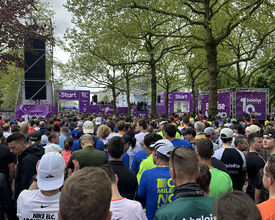In today's competitive event landscape, securing the right sponsorships is critical for the success and sustainability of your events. With event sponsorship driving brand engagement for most consumers, creating compelling sponsorship packages is not just a nice-to-have - it's a must.
However, as budgets tighten and sponsor dollars become more scarce, event planners must be more strategic than ever in designing sponsorship packages that attract the right partners while delivering value to all parties involved.
In this guide, we'll walk you through the essential steps to build sponsorship packages that stand out, align with sponsor goals, and enhance the overall event experience.
Understanding event sponsorship packages
Before diving into the creation process, it's essential to understand what an event sponsorship package entails. Simply put, a sponsorship package is a mutually beneficial contract between an event organiser and a sponsor, where the sponsor provides financial or in-kind support in exchange for promotional opportunities and brand visibility at the event.
These packages are not just about slapping a logo on an event flyer; they are carefully crafted offers that deliver measurable ROI for sponsors while enhancing attendees' experience. The best sponsorship packages provide value to the sponsor, the event organiser, and the attendees - a true win-win-win situation.
Key elements of a successful sponsorship package
When crafting your sponsorship packages, consider these key elements that every package should include:
- Detailed information about your organisation and event: This includes your mission, goals, and the event's purpose, along with logistical details such as the event schedule, expected attendance, and audience demographics.
- Clear sponsorship tiers or customisation options: Depending on your approach, you can offer tiered packages (e.g., Bronze, Silver, Gold, Platinum) or à la carte options that allow sponsors to pick and choose based on their specific needs and budget.
- Defined Benefits and ROI: Sponsors want to know what they will get in return for their investment. This could include brand visibility, lead generation, speaking opportunities, and more. Be sure to outline these benefits clearly in your package.
- Past success stories and testimonials: Share success stories and testimonials from previous sponsors to show potential sponsors the tangible benefits of partnering with you.
- Visual appeal and professional presentation: Ensure your sponsorship package is visually appealing and easily understood. This helps convey professionalism and can make a solid first impression.
Step-by-Step Guide to Creating Event Sponsorship Packages
Step 1: Start With Thorough Research
Thorough research is the foundation of any successful sponsorship package. Begin by analysing past events to identify what worked well and what didn't in previous sponsorship deals. This can help you refine your approach and build on successful strategies.
Next, identify your event's unique selling points (USPs). What sets your event apart from others? Is it the quality of the attendees, unique content, or networking opportunities? Highlight these in your package to make your event more attractive to sponsors.
Additionally, gather audience insights through surveys, social media analytics, and attendee feedback. Understanding your audience's demographics and preferences will help you align your sponsorship packages with potential sponsors' needs and goals.
Finally, research your competitors' events. Understanding what similar events offer can help you differentiate your packages and offer something unique.
Step 2: Understand what sponsors need
To build a package that resonates, you must understand what your potential sponsors are looking to achieve. Engage in direct communication with sponsors to learn about their goals, whether it's brand exposure, lead generation, or showcasing corporate social responsibility (CSR).
Tailor your sponsorship packages to meet these specific needs. For instance, if a sponsor is focused on brand exposure, you might offer prominent logo placement, speaking opportunities, or branded event areas.
Step 3: Craft flexible and enticing packages
Not all sponsors are the same, so your packages shouldn't be either. Offer a range of options to cater to different budgets and goals:
- Tiered sponsorship levels: Provide multiple sponsorship levels, such as Bronze, Silver, Gold, and Platinum. Each tier should offer increasing benefits, allowing sponsors to choose the package that best fits their needs and budget.
- Customised and bespoke packages: Consider offering à la carte options where sponsors can build their packages. This flexibility can appeal to sponsors with specific objectives that may not fit into a pre-defined tier.
- Innovative sponsorship ideas: Think outside the box with packages that include unique experiences or opportunities, such as sponsoring a wellness session, an interactive art installation, or a virtual networking lounge.
How do you price your sponsorship packages?
Pricing sponsorship packages can be complex, but by following a structured approach, you can arrive at a fair and competitive price that reflects the value you offer to sponsors. Here's a step-by-step guide on how to calculate the price of your sponsorship packages:
1. Determine the total value of the sponsorship package
- Estimate the cost of benefits provided: Start by listing all the benefits you are offering in each sponsorship package (e.g., logo placement, speaking opportunities, branded materials, etc.). Estimate the cost of delivering each of these benefits. This includes direct costs (like printing banners) and indirect costs (such as staff time).
- Calculate the event's total reach and engagement: Determine the total number of people exposed to the sponsor's brand through your event, including attendees, online viewers, and social media reach. Use industry standards to assign a monetary value to this exposure. For example, if a social media post is typically valued at $50 per 1,000 impressions, and you estimate 10,000 impressions, that benefit would be valued at $500.
- Include value-added benefits: Consider intangible benefits such as association with a reputable event, networking opportunities, and brand alignment with your audience. While harder to quantify, these can justify higher prices. Assign a value to these based on what similar sponsorships have fetched in the market.
2. Calculate the cost per impression (CPI)
- Estimate Total Impressions: Calculate the number of impressions or interactions the sponsor will receive through all event channels (live event, online streams, social media, ...).
- Determine desired profit margin: Decide on a reasonable profit margin to apply on top of the cost. For example, if your costs for providing the sponsorship package are $5,000 and you want a 50% profit margin, you would add $2,500, making the base price $7,500.
- Adjust for market rates: Compare your calculated CPI and total package cost with what similar events charge. Adjust your prices up or down to remain competitive while still covering your costs and profit margin.
3. Consider the sponsor's expected ROI
- Anticipate sponsor's revenue potential: Estimate how much revenue the sponsor could generate from the sponsorship. For example, if a sponsor expects to gain 100 new leads from the event, and each lead is worth $1,000, that's a potential $100,000 in revenue. Sponsors might be willing to pay 10-20% of that potential revenue, suggesting a sponsorship price of $10,000 to $20,000.
- Calculate break-even point for sponsors: Calculate how many sales or conversions the sponsor would need to return their investment. Ensure that your pricing allows the sponsor to see a clear path to ROI, which makes your package more attractive.
4. Review and adjust annually
- Test the market: Initially, you might price your packages slightly lower to gauge market interest and adjust based on sponsor feedback. Over time, refine your pricing strategy as you gather data on what sponsors are willing to pay.
- Review package performance: After the event, review how well each package performed regarding sponsor satisfaction and your financial goals. Use this data to adjust future pricing.
- Stay competitive: Continuously monitor the market and adjust your pricing to remain competitive and in line with industry trends.
By carefully considering these factors and performing these calculations, you can set prices for your sponsorship packages that are both fair to the sponsor and profitable for your event.
How to pitch and sell sponsor packages for your event or festival
Successfully pitching your sponsorship packages is crucial for securing sponsors that align with your event's goals. A well-crafted pitch can differentiate your event in a competitive market, making it easier to attract the right sponsors. Here's a step-by-step guide on how to pitch sponsorship packages effectively:
1. Research Your Potential Sponsors
Before you begin crafting your pitch, it's essential to know the specific sponsor's background. Repeat the process for every business you will pitch to.
- Understand their business objectives: Research the company's goals, target market, and past sponsorships. Understand what they aim to achieve with their marketing and sponsorship investments. This might include brand awareness, lead generation, corporate social responsibility (CSR), or entering new markets.
- Identify common ground: Determine how your event's audience and goals align with the sponsor's objectives. This alignment is critical for making your pitch compelling. If a tech company is looking to break into new markets, highlight how your event's demographic matches their target audience.
2. Craft a compelling value proposition
Your pitch should clearly articulate the unique value your event offers to potential sponsors:
- Highlight the audience: Detail your event attendees' demographics, interests, and behaviours. Include specifics like age, gender, industry, and job roles and how they align with the sponsor's target market. For example, if your event attracts high-level executives, this could be a prime opportunity for B2B sponsors.
- Showcase ROI potential: Sponsors want to know what's in it for them. Include metrics from past events, such as attendance numbers, social media engagement, and lead generation statistics. Use this data to project potential outcomes for the sponsor. You might say, "Last year's event generated 2,000 qualified leads for our sponsors, with an average engagement rate of 25%."
- Tailor the pitch: Customise your pitch for each potential sponsor. Use their language and address their specific goals. For instance, if a sponsor is focused on lead generation, emphasise your event's networking opportunities and how the sponsorship package facilitates direct engagement with attendees.
3. Develop a professional sponsorship deck
A well-designed sponsorship deck can make a strong visual impact:
- Structure the deck: Start with an introduction to your event, followed by an overview of your audience, sponsorship opportunities, and pricing. End with a clear call to action. Keep the content concise and focused.
- Use Visuals: Incorporate high-quality images, infographics, and charts to make the data more digestible. Visuals help convey the potential impact of sponsorship more effectively than text alone.
- Include testimonials and case studies: If previous sponsors had a successful experience, include their testimonials or case studies. This adds credibility to your pitch and demonstrates that your event can deliver on its promises.
4. Personalise the Approach
Personalisation is key to a successful pitch:
- Direct communication: Arrange face-to-face meetings or video calls with potential sponsors where possible. A personalised approach demonstrates that you value the partnership and have taken the time to understand their needs.
- Tailor the presentation: During the meeting, focus on aspects of the sponsorship package that align closely with the sponsor's objectives. For example, if the sponsor wants brand visibility, emphasise opportunities like stage branding, event app banners, or sponsored sessions.
- Engage in a dialogue: Encourage questions and discussions during your pitch. This interaction allows you to address concerns and refine your offer to meet the sponsor's needs better. It also demonstrates your flexibility and willingness to collaborate.
5. Follow up strategically
After the initial pitch, follow-up is crucial:
- Send a personalised follow-up email: Within 24-48 hours, send a follow-up email thanking the sponsor for their time and reiterating key points from the meeting. Include a link to the sponsorship deck and any additional information they requested.
- Address any concerns: If the sponsor has specific concerns or needs more information, address these in your follow-up. Providing solutions or additional data can help keep the conversation moving forward.
- Keep the communication open: If the sponsor is not ready to commit, keep them engaged by sharing updates about the event, changes in sponsorship opportunities, or early-bird discounts.
6. Negotiate and Close the Deal
Finally, be prepared to negotiate:
- Be flexible on terms: Sponsors may request modifications to the sponsorship package, such as different payment terms, additional benefits, or customised branding opportunities. If these requests align with your event's goals and budget, be open to them.
- Create a sense of urgency: Highlight limited availability of top-tier packages or early-bird discounts to encourage sponsors to commit sooner rather than later.
- Finalise with a contract: Once both parties agree on the terms, draft a detailed sponsorship agreement outlining all aspects of the deal. Ensure it covers deliverables, timelines, and payment terms.
Pitching sponsorship packages requires careful preparation, personalisation, and follow-up. By understanding your potential sponsors' objectives, crafting a compelling value proposition, and maintaining clear and consistent communication, you can secure the right sponsors for your event. With the right approach, your sponsorship pitch will attract sponsors and build long-lasting partnerships that benefit both parties.
Final thoughts: building long-term sponsor relationships
Crafting the perfect sponsorship package is just the beginning. To maintain and grow these relationships, follow up with detailed ROI reports, gather feedback, and offer early renewal incentives. By continually nurturing your sponsor relationships, you'll make it easier to secure sponsorships for future events.
At eventplanner.net, we're committed to helping you achieve success in all aspects of event planning, including sponsorship management. Our robust event software allows you to streamline the management & organisation processes and deliver outstanding value to your sponsors. What are you waiting for? Start crafting your perfect sponsorship package today and watch your events thrive!
This comprehensive guide ensures you have all the tools and insights needed to create sponsorship packages that attract sponsors and add value to your events. If you need further assistance, explore our software's features, and let us help you elevate your next event!






Very insightful article. Helped immensely.